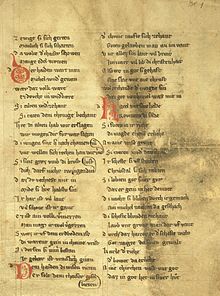Imperial Chronicle
The Kaiserchronik is the first large-scale chronicle written in German rhymes around the middle of the 12th century . It represents the most extensive and most densely transmitted work of early Middle High German literature , which covers the story from Caesar to the Roman-German King Conrad III. tells. "Kaiserchronik" is not the original title, the author originally called the work crônicâ (engraved is iz crônicâ, V. 17) . The current title comes from the Germanist Bernhard Joseph Docen (1782–1828).
History of origin
Probably from 1140 to 1150 by one or more of a Regensburg working farm ministers wrote rhyming chronicle told in rhyming verse 17283 episodenhaft of 36 Roman emperors and German 19. This creates a world chronicle from the foundation of Rome (focus on Caesar) to the preparation of the second crusade in 1147.
It can be assumed (partly because of differences in narrative technique) that several authors contributed to the chronicle. The Pfaffe Konrad , author of the " Rolandslied ", also created in Regensburg, has not been considered as the author of the imperial chronicle since 1924 (cf. Carl Wesle).
A client is difficult to determine because of the abrupt end of the imperial chronicle (an epilogue is missing). It is likely that it was written at a Regensburg ducal or bishop's court .
content
The imperial chronicle is the first important large-scale German-language historical source. When depicting the Roman emperors, the focus is often on the legends of saints associated with them . Above all, the Roman emperors give the author the opportunity to switch on novel-like individual episodes (e.g. Faustinian and New Year's Eve, approx. 2800 verses each (~ 16% of the total volume); Crescentia, 1500 verses (~ almost 9% of the total volume of the chronicle)) that are largely becoming independent. The author tries to do justice to the chronic impetus by apparently precise information about the reigns of the individual rulers; in fact, he seriously changes the succession of the emperors .
Conception
An important concern of the imperial chronicle is the extension of the Roman Empire into the rule of the German emperors according to the doctrine of the four world empires, which was widespread in the Middle Ages . The intention to narrate in an instructive way outweighs the concern to provide a historically precise report. The presentation does not primarily have to correspond to historical truth, but rather to gotes minne (= “God's plan of salvation”, v. 34). The resolution taken in the prologue to tell of good and unhappy rulers is for the most part consistently pursued and has the character of a prince mirror . According to Friedrich Ohly , the individual episodes should not only serve entertainment, but above all have a religious and ethical-exemplary significance. The author wants to differentiate his work from the lies of a purely secular poetry.
swell
There is no single source of the imperial chronicle. The author has used a wide variety of sources, processed them independently, and sometimes treated them freely and willfully.
- Legends and lives of saints
- Legends
- Chronicle of Frutolf von Michelsberg and Ekkehard von Aura as well as Kaiser and Pope catalogs
For single stories:
- Ovid's fasting
- Pseudo-Clementine Recognitions
- Annolied (with striking changes)
- Cassiodors "Historia tripartita"
Lore
The imperial chronicle has been handed down in three different editorships and, with its around 40 carriers, represents the most widely handed down and thus most successful vernacular work of the 12th century ( Kartschoke ). The imperial chronicle is also part of the Vorauer manuscript , a medieval composite manuscript that contains up to is now kept in the Augustinian Canons of Vorau in Styria.
Aftermath
The imperial chronicle has been proven to have an effect on the “Roland song”, the “Trier New Year's Eve”, and probably also on Wolfram's “ Willehalm ”, Ottes “Eraclius”, Frauenlob and Heinrich den Teichner . It is also an important source for later historical works such as the “ Saxon World Chronicle ” and the “World Chronicle” by Jans Enikel and Heinrichs von Munich and Jakob Twingers von Königshofen , which was created more than 150 years later .
literature
1) Text output
- German chronicles and other history books of the Middle Ages 1.1: Deutsche Kaiserchronik. Edited by Edward Schröder . Hanover 1892 ( Monumenta Germaniae Historica , digitized version )
2) research literature
- Eberhard Nellmann: Imperial Chronicle . In: Lexicon of the Middle Ages (LexMA). Volume 5, Artemis & Winkler, Munich / Zurich 1991, ISBN 3-7608-8905-0 , Sp. 856 f. (Sources and literature).
- Eberhard Nellmann: Article Kaiserchronik , in: author Encyclopedia , Vol 4 (1983), 949-964 Sp...
- Friedrich Ohly : saga and legend in the imperial chronicle. Investigations into the sources and structure of poetry (= research on the German language and poetry 10), 2nd edition Darmstadt 1968.
- Alexander Rubel , Caesar and Charlemagne in the imperial chronicle. Typological structure and the translatio imperii ad Francos , in: Antike und Abendland 47 (2001), pp. 146–163.
Web links
- Kaiserchronik: high-resolution digitized version in the culture portal bavarikon
- Publications on the imperial chronicle in the opac of the Regesta Imperii
- Kaiserchronik - digital - edition project of the University of Cambridge on a critical text edition ; As part of the cooperation project, Heidelberg University Library took on the digital presentation with further information.
